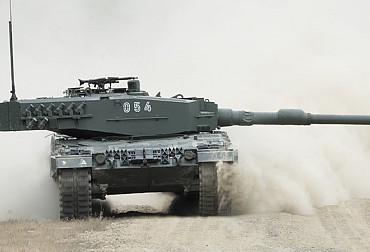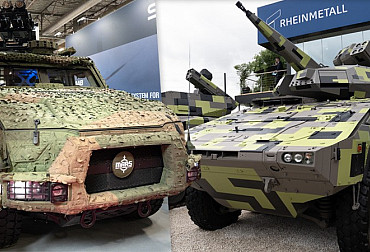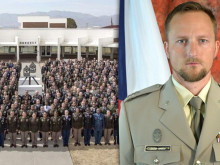What can the Army chefs cook for you?
Do you like sirloin, goulash or maybe even panna cotta ?? The chefs of the 15th Engineer Regiment are able to cook practically everything that the stomach orders. And if someone has a taste for something unconventional, they can have, for example, a dumpling in the color of the national tricolor.
 Picture: They usually cook in „Varna“, which are two ISO containers connected to each other by a door and there are septic tanks underneath. (pictured Varna A + B, followed by POKA 3/1 and Citra car water tank) | Ministry of Defense of the Czech Republic
Picture: They usually cook in „Varna“, which are two ISO containers connected to each other by a door and there are septic tanks underneath. (pictured Varna A + B, followed by POKA 3/1 and Citra car water tank) | Ministry of Defense of the Czech Republic
But military cooking is no fun and requires a lot of skills. "It's mainly about planning, calculation and then at the end about food preparation. Before you go to practice, you must choose a menu in advance, order the necessary ingredients and prepare all the extra dishes and machines. Not to mention the control of the equipment you use to cook. It is either Varna or POKU (Field Kitchen)," the commander of the economic squad of the logistics company of the 152nd Engineer Battalion, Petr Novák, specifies the initial work of all military chefs.
They usually cook in „Varna“, which are two ISO containers connected to each other by a door and there are septic tanks underneath. All waste goes directly to half-containers, which are then usually emptied once a week. "Because with the kitchen you're so-called in the air, everything is more demanding. You still have to run up and down. When there is mud, it can also slip easily. So our work also requires considerable physical condition," Novák says. This is also confirmed by the senior chef of the service platoon of the 15th Engineer Regiment, Sergeant Lukáš Bindr, who is usually in charge of larger events organized directly at the regiment, such as Engineer Day or War Veterans Day. “These festive acts are very demanding. Once I just measured it for fun and I found out that I ran over 20,000 steps a day, which is about 17.5 km.”

Picture: Preparing food for exercise, chefs are wearing brown kitchen clothes in the field. | Ministry of Defense of the Czech Republic
Adherence to strict hygiene regulations is essential for every chef when cooking. “For example, we have separate boards for raw vegetables, cooked and raw meat; as well as knives. We have to have everything marked. We must not knock eggs in the room where we cook. This can then be a problem in the field - where to do it. Another thing is sampling - food and drink. We put them in glasses and store them for 48 hours in a separate refrigerator," Staff Sergeant (OR4) Roman Jakubčík from the service platoon of the 15th Engineer Regiment outlines only a fraction of the rules that every chef, whether during an exercise or in the permanent kitchen must hold. "I have experienced several inspections, both as a civilian and as a soldier, so I can compare. It is 100% stricter for the Army," Jakubčík added and also pointed out that the so-called workshifters also play an important role in the kitchen. "They are different people from the company who work as an auxiliary force. They are designed mainly for cleaning, so they constantly wipe, wash dishes, prepare the dining room and other ancillary work. Without them, the kitchen would not work."

Picture: Military cooking is no fun and requires a lot of skills. | Ministry of Defense of the Czech Republic
Chefs usually have pre-prepared menus, for example for a few weeks in advance, and then select current meals from them for a given period of exercise. As the commander of the economic platoon of the logistics company of the 151st Engineer Battalion, Lieutenant Marek Stručovský, revealed, each menu is precisely broken down into individual raw materials, exact weight and measure. ”We have everything counted per hundred people and we just adjust the numbers. We always try to put food together so that it is properly nutritionally distributed and varied. From the leftovers, we always know which food is popular and which is not. Tomato sauce is not, but sirloin or Peking meat in the style of Chinese food is popular," the lieutenant specified the preparation of the menu.

Picture: Special dumpling in the shape of a Christmas cake and in the colors of the national tricolor (Lt. Marek Stručovský - Kosovo 2009) | Ministry of Defense of the Czech Republic
Although there is usually a real combat conflict practiced in the field, there is also a moment to lighten the atmosphere. "I consider baking strudel for 150 people to be my greatest cooking performance right in the field. We worked on it for about 3 hours and the result was 38 pieces, which is about 15 meters long strudel. Nobody really expected that and I think it was a pleasant change for everyone," Jakubčík described his combat challenge. You can be surprised even with a different color of a well-established dish. "When I was on a foreign mission in Kosovo in 2009, where we cooked for 400 people, we sometimes came up with a joke. E.g. we once dyed classic dumplings green with food coloring. Even though the taste was still the same, people just didn't like it. We once created tricolor-colored dumplings, and it turned out the same way. In this example, it is at least clear that one eats mainly with his eyes," Stručovský explained his experiences from the foreign operation.
The chefs of the 15th Engineer Regiment go out to cook for an average of 4 times a year. Although their working tools are mostly spoons and knives, they have to control the weapons as well as their colleagues. Therefore, they also regularly participate in compulsory employment and exercises.





















